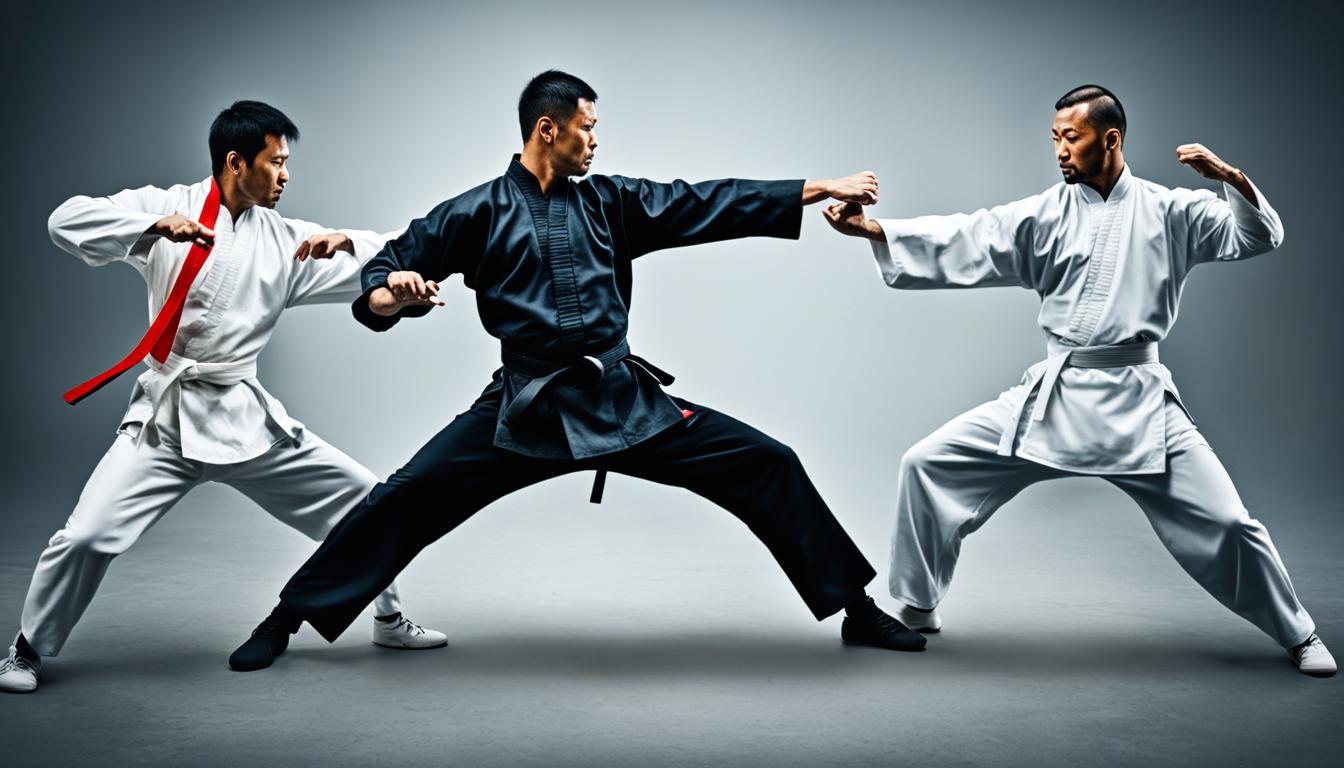Tai Chi and Wing Chun are two popular Chinese martial arts that have captivated practitioners around the world. While both arts share common roots in Chinese culture, they differ significantly in their approach, techniques, and benefits. Understanding the differences between Tai Chi and Wing Chun can help individuals make an informed decision when choosing a martial art that aligns with their goals and preferences.
When comparing Tai Chi and Wing Chun, it’s essential to consider their distinct characteristics. Wing Chun is an external martial art that focuses on linear attacks and close-range combat. It emphasizes direct techniques and close-quarters striking, making it particularly effective for self-defense situations. On the other hand, Tai Chi is an internal martial art with larger, slower, and circular movements. It incorporates the principles of yin and yang, promoting balance and harmony in both the mind and body.
Both Tai Chi and Wing Chun offer unique benefits beyond self-defense. Practicing Tai Chi is renowned for its ability to improve overall health and wellness. It enhances flexibility, balance, and coordination while promoting relaxation and stress reduction. This gentle exercise is suitable for individuals of all ages and fitness levels and is often practiced as a form of moving meditation.
Wing Chun, on the other hand, is particularly appealing to individuals seeking practical self-defense skills. Its techniques are designed to neutralize opponents quickly and efficiently, making it a valuable martial art for personal protection. Wing Chun training also fosters discipline, focus, and mental resilience, cultivating a sense of confidence and empowerment.
Some individuals may choose to explore both Tai Chi and Wing Chun, reaping the unique benefits offered by each martial art. By studying both external and internal styles, practitioners can gain a well-rounded understanding of martial arts principles and techniques.
Key Takeaways:
- Tai Chi and Wing Chun are two distinct Chinese martial arts with different techniques and philosophies.
- Wing Chun focuses on linear attacks and close-quarters combat, making it effective for self-defense.
- Tai Chi emphasizes larger, slower, circular movements and promotes health, wellness, and relaxation.
- Both arts offer unique benefits and practitioners may choose to study both for a well-rounded martial arts experience.
- The choice between Tai Chi and Wing Chun should depend on an individual’s goals and preferences.
The History and Origins of Wing Chun
Wing Chun is a Chinese martial art with a rich history that can be traced back to the 17th century. While the exact origins are shrouded in mystery due to limited written records, Wing Chun has a captivating origin story that blends historical facts with folklore.
According to popular belief, Wing Chun was developed by a Buddhist nun named Ng Mui. Seeking to create a fighting style that could overcome stronger opponents, Ng Mui incorporated concepts of leverage and force into her martial art. She combined her knowledge of Shaolin Kung Fu with her deep understanding of human anatomy and created a system characterized by efficiency and effectiveness.
Wing Chun’s origin story also includes a legendary figure named Yim Wing Chun, who is said to have learned the martial art from Ng Mui. Yim Wing Chun’s name became associated with the style, contributing to its name. However, the historical accuracy of this specific narrative is still a topic of debate among Wing Chun practitioners.
One of the most prominent figures in Wing Chun history is Ip Man, a renowned master who popularized the art and influenced generations of practitioners. Ip Man’s most famous student, Bruce Lee, brought Wing Chun to international prominence through his own interpretation of the style.
Today, Wing Chun is recognized for its distinct techniques, practicality, and effectiveness in combat. It emphasizes close-range combat and utilizes simultaneous attacks and defense. The system is characterized by its economy of motion, precise footwork, and the centerline theory, which focuses on maintaining control of the opponent’s centerline.
Key Features of Wing Chun:
- Compact and efficient techniques
- Focus on the centerline theory
- Sensitivity training to develop reflexes and awareness
- Utilization of short-range punches, kicks, and trapping techniques
- Integration of both striking and grappling principles
The Philosophy and Benefits of Tai Chi
Tai Chi is a martial art deeply rooted in Taoist and Buddhist philosophies, emphasizing the balance of yin and yang and achieving harmony in both the mind and body. It is not simply a physical exercise but also a form of moving meditation and mindfulness practice.
The slow, deliberate movements of Tai Chi promote a state of relaxation and calmness, making it an ideal practice for stress reduction. By combining gentle movements with deep, controlled breathing, practitioners cultivate a sense of inner peace and tranquility.
Regular practice of Tai Chi offers a myriad of health benefits. It improves physical fitness by enhancing strength, flexibility, and balance. The flowing movements help to enhance circulation, stimulate the immune system, and support overall cardiovascular health.
Tai Chi is also renowned for reducing stress levels and improving mental well-being. The deliberate focus on deep breathing and mindfulness connects the mind and body, promoting mental clarity and reducing anxiety. It has even been shown to be beneficial for individuals with depression, improving mood and overall psychological well-being.
Furthermore, Tai Chi is a gentle, low-impact exercise suitable for individuals of all ages and fitness levels. It can be practiced indoors or outdoors, alone or in a group setting. The accessibility and versatility of Tai Chi make it an excellent choice for people seeking a holistic approach to health and wellness.
Overall, the philosophy and practice of Tai Chi offer a path to holistic well-being, encompassing physical fitness, mental resilience, and emotional balance. It is a powerful tool for relaxation, stress reduction, and cultivating a sense of inner harmony.
Tai Chi vs. Wing Chun: Comparison of Fighting Styles
When comparing Tai Chi and Wing Chun for self-defense, Wing Chun is generally considered to be more effective due to its direct focus on fighting techniques and linear attacks. Wing Chun practitioners train to intercept and attack, with a strong emphasis on sensitivity training. Tai Chi, on the other hand, incorporates circular movements and focuses on redirecting an opponent’s energy rather than directly engaging in combat.
Tai Chi emphasizes the flow of energy, relaxation, and improving overall health and well-being. Its slow and deliberate movements promote balance, flexibility, and coordination. Although it may not be as explicitly focused on self-defense, Tai Chi can still be applied effectively in certain situations, using leverage, redirection, and timing to neutralize an opponent’s attack.
Wing Chun, with its direct, aggressive approach, provides practitioners with practical self-defense techniques that can be used effectively in real-life scenarios. It emphasizes close-range combat and rapid, efficient strikes. Its training methods and techniques are designed to optimize speed, power, and precision.
Both arts have their own unique techniques and approaches to fighting, catering to different goals and preferences. Some individuals may be drawn to Tai Chi for its holistic benefits and mind-body connection, while others may prefer Wing Chun for its practical and combative focus. Ultimately, the choice between Tai Chi and Wing Chun as a self-defense martial art depends on the individual’s personal goals, interests, and physical capabilities.
Differences in Techniques:
- Wing Chun: Linear attacks, fast and explosive strikes, trapping and blocking techniques, close-range combat.
- Tai Chi: Circular movements, energy redirection, leverage, controlled breathing, balance, and flow.
Conclusion
In conclusion, when comparing Tai Chi and Wing Chun, it is evident that these two martial arts offer distinct philosophies, techniques, and benefits. While Wing Chun is renowned for its effectiveness in self-defense, with a direct focus on fighting techniques and linear attacks, Tai Chi primarily emphasizes health, wellness, relaxation, and stress reduction.
Choosing between Tai Chi and Wing Chun ultimately depends on individual preferences and goals. If self-defense is a top priority, Wing Chun may be the preferred choice due to its practical fighting techniques and emphasis on intercepting and attacking opponents. However, for those seeking to improve overall well-being, promote relaxation, and achieve mind-body harmony, Tai Chi offers a myriad of benefits.
It’s worth noting that some practitioners opt to study both Tai Chi and Wing Chun to gain a comprehensive understanding of external and internal martial arts. This approach allows individuals to benefit from the unique techniques and perspectives each art offers, combining the self-defense effectiveness of Wing Chun with the health and wellness benefits of Tai Chi.
Ultimately, whether you choose Tai Chi, Wing Chun, or a combination of both, these martial arts provide valuable tools for personal growth, self-defense, and physical and mental well-being.


